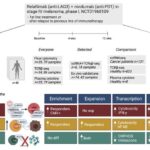- 認知機能療法は、慢性腰痛をその人の痛み体験全体の一部として治療するものですが、その効果を評価するためには、より多くの研究が必要です。
Cognitive Functional Therapy treats chronic back pain as part of a person’s entire pain experience, but more research is needed to assess its effectiveness.
- 慢性腰痛の痛みと障害の軽減に対する認知機能療法の効果:システマティックレビューとメタアナリシス Effectiveness of cognitive functional therapy for reducing pain and disability in chronic low back pain: a systematic review and meta-analysis
- 慢性腰痛患者における疼痛強度に対する段階的な感覚運動再教育の効果 無作為化臨床試験 Effect of Graded Sensorimotor Retraining on Pain Intensity in Patients With Chronic Low Back Pain A Randomized Clinical Trial
認知機能療法は、慢性腰痛をその人の痛み体験全体の一部として治療するものですが、その効果を評価するためには、より多くの研究が必要です。 Cognitive Functional Therapy treats chronic back pain as part of a person’s entire pain experience, but more research is needed to assess its effectiveness.
2023-03-02 ニューサウスウェールズ大学(UNSW)
CFTは痛み教育、運動、ライフスタイルコーチングなどを統合した治療法で、患者の痛み体験全体を考慮した治療を提供することを目的としている。レビューによれば、CFTはこれまでの研究からは従来の治療法よりも効果的ではなく、より大規模な被験者を対象とする盲検試験が必要であるとされた。
<関係資料>
- https://newsroom.unsw.edu.au/news/health/review-finds-fledgling-chronic-back-pain-therapy-needs-more-rigorous-study
- https://www.jospt.org/doi/10.2519/jospt.2023.11447
- https://jamanetwork.com/journals/jama/fullarticle/2794765
慢性腰痛の痛みと障害の軽減に対する認知機能療法の効果:システマティックレビューとメタアナリシス Effectiveness of cognitive functional therapy for reducing pain and disability in chronic low back pain: a systematic review and meta-analysis
Jack J Devonshire, Michael A Wewege, Harrison J Hansford,Hasibe A Odemis, Benedict M Wand, Matthew D Jones, James H McAuley
Journal of Orthopaedic & Sports Physical Therapy Published:February 22, 2023
DOI:https://www.jospt.org/doi/10.2519/jospt.2023.11447
Abstract
OBJECTIVE: To evaluate whether cognitive functional therapy (CFT) is an effective treatment for adults with chronic low back pain (LBP)
DESIGN: Intervention systematic review with meta-analysis.
LITERATURE SEARCH: CENTRAL, CINAHL, MEDLINE, Embase, clinicaltrials.gov, EU clinical trials register (to March 2022).
STUDY SELECTION CRITERIA: Randomised controlled trials evaluating CFT for adults with LBP.
DATA SYNTHESIS: The primary outcomes were pain intensity and disability. Secondary outcomes were psychological status, patient satisfaction, global improvement, and adverse events. Risk of bias was assessed using the Cochrane Risk of Bias 2 tool. Certainty of evidence was assessed using the Grading of Recommendations Assessment, Development and Evaluation approach. Random-effects meta-analysis with the Hartung-Knapp-Sidik-Jonkman adjustment was used to estimate pooled effects.
RESULTS: Fifteen trials were included (nine ongoing, one terminated), of which five provided data (n=507; n=262 CFT and n=245 control). There was very low certainty for the effectiveness of CFT compared to manual therapy plus core exercises (two studies, n=265) for reducing pain intensity (mean difference -1.02/10, 95% CI -14.75 to 12.70) and disability (mean difference -6.95/100, 95% CI -58.58 to 44.68). Narrative synthesis showed mixed results for pain intensity, disability, and secondary outcomes. No adverse events were reported. All studies were judged to be at high risk of bias.
CONCLUSION: CFT may not be more effective than other common interventions for reducing pain and disability in adults with chronic LBP. The effectiveness of CFT is very uncertain and will remain so until higher quality studies are available.
慢性腰痛患者における疼痛強度に対する段階的な感覚運動再教育の効果 無作為化臨床試験 Effect of Graded Sensorimotor Retraining on Pain Intensity in Patients With Chronic Low Back Pain A Randomized Clinical Trial
Matthew K. Bagg, Benedict M. Wand, Aidan G. Cashin, Hopin Lee, Markus Hübscher, Tasha R. Stanton, Neil E. O’Connell, Edel T. O’Hagan, Rodrigo R. N. Rizzo, Michael A. Wewege, Martin Rabey, Stephen Goodall, Sopany Saing, Serigne N. Lo, Hannu Luomajoki, Robert D. Herbert, Chris G. Maher, G. Lorimer Moseley, James H. McAuley
Journal of the American Medical Association Published:August 2, 2022
DOI:10.1001/jama.2022.9930
Key Points
Question What is the effect of a graded sensorimotor retraining intervention on pain intensity for adults with chronic low back pain?
Findings In this randomized clinical trial that included 276 participants, a graded sensorimotor retraining intervention, compared with a sham procedure and attention control, resulted in a statistically significant improvement in pain intensity at 18 weeks (estimated mean difference, 1.0 point on an 11-point numeric rating scale [range, 0-10 points]).
Meaning Among patients with chronic low back pain, a graded sensorimotor retraining intervention, compared with a sham procedure and attention control, significantly improved pain intensity at 18 weeks, although the improvements were modest and further research in other patient populations is needed to understand the generalizability of the findings.
Abstract
Importance The effects of altered neural processing, defined as altering neural networks responsible for perceptions of pain and function, on chronic pain remains unclear.
Objective To estimate the effect of a graded sensorimotor retraining intervention (RESOLVE) on pain intensity in people with chronic low back pain.
Design, Setting, and Participants This parallel, 2-group, randomized clinical trial recruited participants with chronic (>3 months) nonspecific low back pain from primary care and community settings. A total of 276 adults were randomized (in a 1:1 ratio) to the intervention or sham procedure and attention control groups delivered by clinicians at a medical research institute in Sydney, Australia. The first participant was randomized on December 10, 2015, and the last was randomized on July 25, 2019. Follow-up was completed on February 3, 2020.
Interventions Participants randomized to the intervention group (n = 138) were asked to participate in 12 weekly clinical sessions and home training designed to educate them about and assist them with movement and physical activity while experiencing lower back pain. Participants randomized to the control group (n = 138) were asked to participate in 12 weekly clinical sessions and home training that required similar time as the intervention but did not focus on education, movement, and physical activity. The control group included sham laser and shortwave diathermy applied to the back and sham noninvasive brain stimulation.
Main Outcomes and Measures The primary outcome was pain intensity at 18 weeks, measured on an 11-point numerical rating scale (range, 0 [no pain] to 10 [worst pain imaginable]) for which the between-group minimum clinically important difference is 1.0 point.
Results Among 276 randomized patients (mean [SD] age, 46 [14.3] years; 138 [50%] women), 261 (95%) completed follow-up at 18 weeks. The mean pain intensity was 5.6 at baseline and 3.1 at 18 weeks in the intervention group and 5.8 at baseline and 4.0 at 18 weeks in the control group, with an estimated between-group mean difference at 18 weeks of -1.0 point ([95% CI, -1.5 to -0.4]; P = .001), favoring the intervention group.
Conclusions and Relevance In this randomized clinical trial conducted at a single center among patients with chronic low back pain, graded sensorimotor retraining, compared with a sham procedure and attention control, significantly improved pain intensity at 18 weeks. The improvements in pain intensity were small, and further research is needed to understand the generalizability of the findings.



